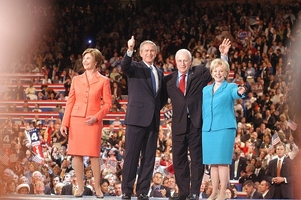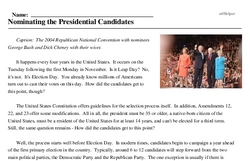Nominating the Presidential Candidates
Caption: The 2004 Republican National Convention with nominees George Bush and Dick Cheney with their wives
It happens every four years in the United States. It occurs on the Tuesday following the first Monday in November. Is it Leap Day? No, it's not. It's Election Day. You already know millions of Americans turn out to cast their votes on this day. How did the candidates get to this point, though?
The United States Constitution offers guidelines for the selection process itself. In addition, Amendments 12, 22, and 23 offer some modifications. All in all, the president must be 35 or older, a native-born citizen of the United States, must be a resident of the United States for at least 14 years, and can't be elected for a third term. Still, the same question remains - How did the candidates get to this point?
Well, the process starts well before Election Day. In modern times, candidates begin to campaign a year ahead of the first primary election in the country. Typically, around 6 to 12 candidates will step forward from the two main political parties, the Democratic Party and the Republican Party. The one exception is usually if there is already a popular incumbent president who is looking to be reelected. Then the challengers often come primarily from the other political party.
These earliest of candidates wish to make a name for themselves early on. They need to stand out and become a household name. These candidates will announce their campaign. Then they travel to different locations giving speeches and debating with candidates from their own party.




